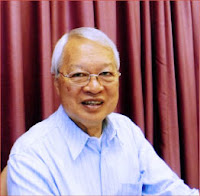[信訊舊文重溫]
聖週:禮儀及靈修的高峰
(六)
復活主日
----------------------------------------
我母校澳門聖若瑟大學有慶曾邀得著名禮儀學家安鵬浩神父客座,教授禮儀神學一課。我曾在2009/10學年習修該課;並在(二零一零年)三月十日參與由天主教香港教區禮儀委員會主辦,由國際知名的禮儀學家安鵬浩神父所主講的禮儀講座。在即日徵得講者安神父同意後,曾在澳門堂聯《信訊雙週刊》編譯講座主要內客。今天重溫舊文,希望能與大家一同重溫聖週各禮儀行動中更深入的意思,從而度一個更豐碩的聖週。
----------------------------------------
復活主日
1.
「基督已經復活了!」及其回應「祂真的復活了!」。這是東方禮基督徒之間的問候方式,持續五十天,直到五旬節為止。事實上,復活期的五十天就好像長得沒有終結的喜樂的一天。復活期以莊嚴的聖神降臨達到其高峰,就如基督的復活以賜下聖神來達致高峰一樣。
2.
亞肋路亞充斥著彌撒的禮儀和時辰頌禱禮。亞肋路亞是典型的復活期歡呼,並在整個復活期之中不斷迴響。為了更強調亞肋路亞的重要性,羅馬教會(從第六世紀起)從聖灰星期三直都復活守夜之間都不唱亞肋路亞。而這羅馬慣例後來更被東方禮教會所懷疑,以致到第十四世紀成為兩者之間的爭論。
3.
光榮頌是復活節的另一個要素。儘管其首句是眾天使在聖誕晚所唱的,光榮頌本身是與復活節有關。在第六世紀時期,光榮頌只可在主教主持的彌撒中頌唱,而在司鐸主持的彌撒中唱光榮頌的唯一機會,就是復活節。
4.
巴斯卦蠟燭和復活基督的圖像可置於聖所內五十天之久。放置巴期卦蠟燭的最佳位置是在讀經台的旁邊,且在復活期內的所有彌撒和聖洗聖事中都要將之燃點。
5.
從莊嚴性的角度來說,復活守夜禮的靈修和禮儀豐碩對復活主日慶典只有些微影響。除了可以在復活主日彌撒中重宣領洗宣願和唱出復活期繼抒詠外,從實踐上說,在某些地方,其禮儀莊嚴程度已被降低至跟常年期主日差不多。
安鵬浩神父(Rev. Anscar J. Chupungco O.S.B.),本篤會士,菲律賓保祿六世禮儀學院主任,菲律賓天主教主教團禮儀委員會執行秘書。他曾任教於宗座羅馬聖安瑟莫禮儀學院超過20年,亦曾出任宗座聖禮部顧問。他已於2013年1月9日安息主懷。
English Original:
[Both text and audio can be downloaded from the website of the Hong Kong Catholic Diocesan Liturgy Commission]
LITURGY AND SPIRITUALITY OF HOLY WEEK
Anscar J. Chupungco, OSB
EASTER SUNDAY
1. "Christ is risen!" and the response "He is truly risen!". This is the greeting among Oriental Christians for fifty days, until Pentecost. In fact, the fifty days of Easter are like one long and endless day of rejoicing. The season of Easter culminates in the solemnity of Pentecost, just as the resurrection of Christ culminated in the bestowal of the Holy Spirit.
2. Alleluia fills the liturgy of the Mass and the liturgy of the hours. Alleluia is the typical Easter acclamation that resounds during the season. To heighten it the Roman Church (from the sixth century) did not sing the Alleluia from Ash Wednesday to Easter Vigil. This Roman practice was questioned by the Oriental Churches and became one of the items of controversy between Rome and the Orthodox Churches as late as the fourteenth century.
3. The Gloria is another Easter component. Although its opening lines refer to the song of the angels on Christmas night, it was originally associated with Easter. There was a time in the sixth century when it was sung only at the bishop’s Masses and was allowed to priests only on Easter.
4. For fifty day the paschal candle and the image of the Risen Christ are kept in the sanctuary. The paschal candle is best positioned beside the ambo and is lighted in all Masses and baptisms during the Easter Season.
5. The spiritual and liturgical richness of Easter Vigil has affected only in a limited way the celebration of Easter Sunday in terms of solemnity. Except for the possibility of renewing the baptismal vows on Easter Sunday Masses and the chanting of the Easter sequence, the liturgy is practically reduced, in some places, to that of an ordinary Sunday.

沒有留言:
張貼留言